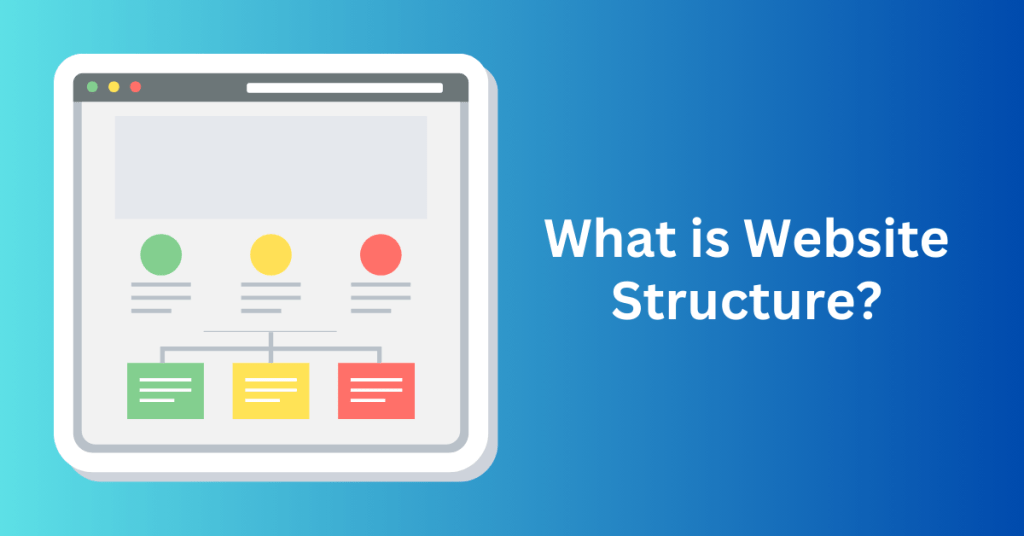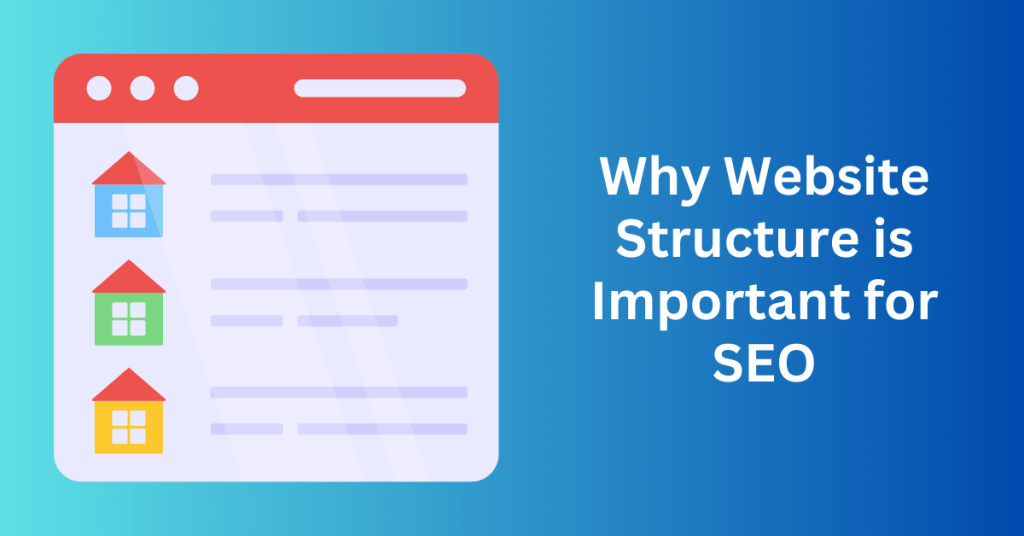The architecture of your website plays an important role in any effective search engine optimization (SEO) strategy. It communicates to Google and other search engines the key elements and priorities of your website. The structure of your website directly influences which web pages and content pieces rank higher on search engine result pages (SERPs).
While developing an SEO strategy, it’s common to emphasize keywords, linking, and content quality. However, without a clear and optimized website structure, these efforts may not yield significant results.
Whether you are launching a new website or enhancing an existing one, understanding website structure for SEO is essential. Here’s a comprehensive guide covering all you need to know:
What is Website Structure?

Website architecture, or the structure of your website, dictates how your web pages are organized and interconnected. It lays the groundwork for the design and content that will be added later.
Typically, website architecture begins with the homepage and extends into various pages or subcategories.
An SEO-friendly website architecture is designed to organize your website so that search engines like Google can easily understand and prioritize it. Just as a well-organized bookshelf helps you find your favourite novel quickly, a well-structured website enables search engines to effortlessly locate and index your web pages.
Why is this important?
Imagine your website as a party you’re hosting. You want to guide your guests (both users and search engines) smoothly from the entrance to the dining area, avoiding them getting lost in a labyrinth of rooms and corridors. When search engines can navigate your site easily, they reward you with better visibility in search results.
In basic terms, website structure can be categorized as flat or deep.
Flat website architecture aims to provide users with information in as few clicks as possible. Conversely, deep website architecture allows for the creation of specific topic pages and longer paths for users to find information.
Most modern websites use a flat structure. This can ensure that important pages are easily accessible and enhance navigation for users and search engines.
Four Types of Website Structure
To go deeper, there are four types of website architecture:
- Hierarchical model: This architecture features main parent pages followed by more detailed child pages.
- Sequential model: This structure guides users through a sequence of pages, either backwards or forward.
- Matrix model: This model presents numerous topic groups to users. It allows them to choose where to navigate next, instead of following a “parent/child” or sequential path.
- Database model: This architecture relies on content metadata and information architecture principles. While more complex to implement, it allows users to create their own experience on the site.
Get Your Web Hosting Now – Exclusive Offer Available
Why Website Structure is Important for SEO

Good site structure is a significant factor for SEO. Here’s why:
Guide for Google Crawling Bot
An effectively designed website structure, characterized by intuitive navigation and a robust internal linking system, plays a crucial role in assisting Google bots to navigate and understand the content of your website more efficiently. When your website is well-structured, it becomes easier for search engine crawlers to index and rank your pages accurately.
Furthermore, a carefully planned sitemap and internal linking strategy can provide valuable insights to search engine bots regarding the hierarchy and importance of different pages on your site. By strategically linking relevant pages and establishing a clear sitemap, you can guide search engine crawlers to prioritize and recognize the most critical content, thus potentially improving the overall visibility and ranking of your website in search engine results.
This approach not only enhances the user experience by smoother navigation but also contributes significantly to your site’s SEO performance.
Increase in Organic Traffic
Having an SEO-friendly website is instrumental in achieving higher rankings on search engine results pages (SERPs). This ultimately enhances visibility and draws increased organic traffic to your site. When your website is optimized for SEO, it becomes more likely to appear prominently in search results. This will make it easier for potential visitors to discover and engage with your content.

Moreover, a well-structured website that offers relevant and easily accessible content can effectively reduce the bounce rate. By presenting users with valuable information in a user-friendly format, visitors are more likely to stay longer on your site, exploring different pages and engaging with the content. This increased engagement not only improves the overall user experience but also signals to search engines that your website is valuable and authoritative. This can lead to further SEO benefits such as improved rankings and increased organic traffic.
Helps Determines Sitelinks
Sitelinks are additional links to specific subpages of your website that Google displays beneath your main URL in search engine results. They provide users with direct access to relevant sections of your site, enhancing navigation and improving user experience.
The generation of sitelinks is influenced by your website’s internal linking structure. Google analyzes the way your site is organized and how internal pages are connected to determine which subpages to display as sitelinks. Generally, pages that are prominently linked through main navigation tabs, menus, or footer links are considered more important by Google and are more likely to be featured as sitelinks.
By strategically organizing and optimizing your internal links, you can influence which subpages Google identifies as significant. This can ultimately improve the visibility and accessibility of key sections of your website. Hence, leading to a better overall user experience and potentially higher click-through rates from search engine results pages.
Improved User Experience
Ensuring that your website is easy to navigate is essential for providing a positive user experience. A well-organized website structure facilitates usability by allowing visitors to swiftly locate the information or products they seek. When users can easily find what they need, they are more likely to stay on your site longer and engage with your content or offerings.
Conversely, a disorganized or cluttered website structure can be frustrating for users and may drive them to seek alternatives. A messy structure can confuse visitors. This can lead to higher bounce rates as users quickly leave the site without finding what they need. Additionally, a poor user experience due to a complicated layout or unclear navigation paths can negatively impact conversions, as users may abandon their intended actions, such as making a purchase or filling out a form.
Therefore, investing in a well-planned and intuitive website structure is crucial for retaining visitors, reducing bounce rates, and ultimately improving conversions. By prioritizing user-friendly navigation and clear organization, you can enhance the overall usability of your website and create a more positive impression that encourages users to engage with your content and achieve their objectives efficiently.
Increased Engagement and Conversions
Making it easy for users to navigate and locate desired information or products on your website is key to converting visitors into customers. When users encounter a seamless and intuitive navigation experience, they are more inclined to engage with your offerings and complete desired actions. It can be making a purchase or submitting a contact form.
Users prefer a straightforward and intuitive browsing experience. This is where they don’t have to spend time figuring out where to click or how to navigate through your site. A clean and well-structured website design that emphasizes clarity and simplicity enhances user satisfaction and encourages conversion.
A robust website design and architecture play a vital role in supporting this user-centric approach. By implementing logical navigation paths, clear calls-to-action, and organized content layouts, you can guide users through their journey on your site effectively. This not only improves user engagement but also builds trust and credibility, ultimately increasing the likelihood of conversions.
Content Planning
The architecture of your website serves as the backbone that supports your overall web design and content strategy. By establishing a well-organized structure and optimizing it for SEO, you lay the groundwork for effective content placement and user engagement.
Once you have defined the structure of your website and ensured its SEO-friendliness, you can strategically plan the placement and presentation of content. This includes identifying key areas for category pages, prominent landing pages, targeted keywords, and relevant content sections.
Subsequently, you can develop a website wireframe. A skeletal framework that outlines the basic structure and layout of your web design based on the established site architecture. The wireframe then provides a visual representation of how different elements will be arranged and organized within the website interface, aligning with the predefined site structure.
After creating the wireframe, you can further refine the content strategy by determining specific locations for category pages, landing pages optimized for important keywords, and engaging content sections. This step-by-step approach ensures that your website design aligns with your SEO objectives and user experience goals, optimizing the overall effectiveness and impact of your digital presence.
Scalability
A well-structured website architecture provides a solid foundation that is easier to optimize and scale as your business evolves and expands. With a clear understanding of your site’s structure, you gain insights into where new pages can be added, which existing content may need to be updated or removed, and how to strategically organize and prioritize different sections of your website.
This approach is particularly important from an SEO perspective, given the dynamic nature of search engine algorithms and user behaviours. Keywords and search trends evolve, and what is relevant today may not be as impactful in the future. A flexible and organized website architecture allows you to adapt more effectively to these changes by making it easier to optimize for new keywords and adjust your content strategy to better reach your target audience.
On the other hand, a cumbersome or confusing website structure can hinder SEO efforts. A disorganized layout makes it challenging to identify and implement necessary optimizations. This can lead to inefficiencies in targeting new keywords and delivering relevant content to users.
Get Your Web Hosting Now – Exclusive Offer Available
How to Structure a Website
We’ve laid out some of the steps involved in structuring your website. Let’s take a deeper look at the process:
1. Create an SEO-Friendly URL Structure – SEO-Friendly Website Structure
To establish a strong foundation for your website’s SEO, start by purchasing a domain name if you haven’t. Once you have your domain secured, focus on optimizing your URL structure. It plays a critical role in search engine optimization (SEO) by communicating the content and relevance of your pages to search engine crawlers.
Here are key considerations for crafting SEO-friendly URLs:
- Descriptive and Concise: Ensure that your URLs clearly describe what a user can expect to find on the corresponding page. Keep them concise and avoid unnecessary words or characters.
- Incorporate Keywords: Whenever possible, include relevant keywords in your URLs. This helps search engines understand the topic and context of your content.
- Use Hyphens for Word Separation: Use hyphens (-) to separate words in your URLs instead of underscores (_) or spaces. Hyphens are more readable and favoured by search engines.
- Keep URLs Lowercase: Use lowercase letters for URLs to maintain consistency and avoid potential issues with case sensitivity.
- Avoid Duplicate URLs: Each page should have a unique URL. Avoid creating multiple URLs that lead to the same content. This can cause indexing issues and dilute your SEO efforts.
- Be Future-Proof: Design your URL structure with scalability in mind. Plan for future content additions and changes to ensure that your URLs remain logical and organized over time.
By following these guidelines and best practices, you can enhance the visibility and ranking potential of your website’s main categories and product pages in Google searches. This will ultimately drive more targeted organic traffic to your site.
2. Check Out Your Competitors – SEO-Friendly Website Structure
When building a website structure, especially for a larger site, it can be beneficial to study and learn from high-ranking competitors or industry giants to inform your strategy and potentially surpass their approach.
Here’s how you can approach this process:
- Identify High-Ranking Competitors: Use SEO tools to identify competitors that consistently rank well in search results for relevant keywords in your niche. Then, analyze their websites to understand how they have structured their content and organized their navigation.
- Study Competitors’ Best-Performing Sections: Focus on the sections or pages of your competitors’ websites that attract the most traffic or engagement. Then, identify what makes these sections successful, such as clear navigation, compelling content, or effective user experience.
- Utilize SEO Tools for Insights: Leverage SEO tools to gain insights into your competitors’ SEO performance, keyword strategies, and content effectiveness. Look for opportunities to replicate or improve upon their strategies on your own website.
- Learn from Industry Giants: For larger niches or industries, study the website structures of industry giants like Amazon, eBay, or other prominent players. While you may not replicate their extensive categories or scale, you can analyze their successful elements such as user interface, navigation menus, and product organization.
- Implement Best Practices on Your Website: Incorporate the insights and lessons learned from your competitor analysis into your own website structure. Adapt successful strategies to fit your unique business needs and audience preferences.
By studying successful competitors and industry leaders, you can gain valuable insights into effective website structuring, content organization, and user experience optimization. This research enables you to make informed decisions that enhance your website’s usability, SEO performance, and overall competitiveness in your market.
3. Plan a Website Hierarchy – SEO-Friendly Website Structure

Designing your website’s hierarchy plays a crucial role in determining the organization and prioritization of your web pages. At the forefront are high-priority pages such as product listings, services offered, pricing details, and contact forms. These primary pages often encompass additional sections and subcategories that provide more detailed information.
Conducting thorough keyword research is imperative when structuring this hierarchy. It guides the strategic placement of your main keywords within the architecture. Secondary keywords can be strategically integrated into specific topic-focused, product-related, or service-specific pages.
Moreover, your website’s hierarchy encompasses information architecture, which defines how relevant content is structured and dispersed across the site.
Typically, a hierarchical pyramid model is employed where the most critical content is prominently featured on the homepage, serving as the gateway to deeper information dispersed across secondary pages and subsections.
Search engines leverage website hierarchy to evaluate page importance. It’s a factor that directly influences their ranking on search engine results pages (SERPs). This can ensure that high-value pages like your homepage or primary product listings maintain superior visibility and prevent lower-level service pages from overshadowing them in search rankings.
4. Clear Out Your Website Navigation – SEO-Friendly Website Structure
Effective navigation is a fundamental aspect of website design, significantly impacting user experience and lead generation. Well-designed navigation facilitates seamless movement between pages, hence enhancing user engagement and conversion rates.
A prominently placed top-level navigation menu is essential for any website, regardless of complexity. An intuitive, user-friendly navigation bar positioned below the header provides straightforward access to key sections and functionalities.
Many websites fall into the trap of cluttering their navigation with unnecessary pages. Hence, it’s crucial to streamline and prioritize essential links, removing any extraneous or redundant pages to enhance clarity and usability.
Besides, you should simplify access to critical revenue-generating or inquiry-focused pages by ensuring they are easily discoverable within the navigation. Product features, pricing details, and other vital information should be readily accessible, while supplementary content can be nested within subpages.
Excessive and irrelevant links in your navigation can hinder search engine crawlers, impeding their ability to navigate and index your site effectively. This can adversely impact your search engine rankings. Hence, you should emphasize the importance of optimizing navigation for both users and search engines.
For e-commerce websites, implementing faceted navigation or filters is essential. These tools enable users to refine search results based on specific criteria, enhancing the browsing experience and facilitating quicker purchase decisions.
5. Use Breadcrumbs – SEO-Friendly Website Structure
Breadcrumbs are a valuable yet often overlooked aspect of website navigation and SEO strategy. These navigational aids appear below the header and provide users with a clear path to navigate through a website’s hierarchy.
Implementing breadcrumbs encourages a logical approach to website organization, facilitating the creation of a structured and SEO-friendly website layout. They contribute to an enhanced user experience by offering clear navigation cues and reducing user confusion.
A well-defined website architecture, complemented by breadcrumbs, plays a pivotal role in optimizing search engine crawling and indexing processes. This refined structure enables search engines to better understand and categorize website content, increasing the likelihood of displaying relevant sitelinks when users search for specific keywords or phrases.
6. Prioritize Security and User Experience – SEO-Friendly Website Structure

Security is a critical concern for both search engines and users. And Google is giving priority to websites secured with HTTPS. The presence of HTTPS not only enhances search engine rankings but also instills trust in users, who recognize it as a sign of a secure and legitimate website. It reduces the risk of encountering scams or malicious websites. Therefore, ensuring your website uses HTTPS is imperative for both SEO and user safety.
In addition to security, optimizing your website structure for user experience is essential. Users should be able to navigate to their desired destination with minimal clicks, ensuring efficient and intuitive browsing. A streamlined structure reduces frustration and improves overall engagement.
Consistency in website design and structure is another key aspect of user experience. Maintaining a cohesive layout and navigation system across all pages fosters familiarity and ease of use. Sudden or drastic changes in navigation can confuse visitors and disrupt the user journey.
For newcomers entering a specific industry or niche, studying successful competitors can provide valuable insights. Analyzing the navigation and layout of industry leaders and emulating their approach can create a sense of familiarity for visitors and establish credibility. However, it’s important to add your unique touch and tailor the structure to meet the specific needs and preferences of your target audience.
7. Build a Comprehensive Internal Linking Structure – SEO-Friendly Website Structure
Finally, develop a comprehensive internal linking strategy aimed at enhancing SEO performance. By establishing a network of links connecting various pages and content within your website, you facilitate smoother navigation for search engine crawlers. This, in turn, enables Google to better comprehend your site’s structure, potentially enhancing your search rankings. Incorporate descriptive anchor text to optimize the relevance of these internal links.
In addition to aiding search engines, internal links guide users from one article or page to another, or towards related products or services. The longer visitors remain engaged on your website, the greater the likelihood of converting them into valuable leads.
Get Your Web Hosting Now – Exclusive Offer Available
Audit your website’s SEO architecture
Just as routine check-ups maintain your health, conducting a thorough SEO audit keeps your website in top shape. But how should you approach it?
Utilize a range of tools such as Google Search Console to get into your website’s inner workings. These tools comb through your site and furnish you with a comprehensive report detailing both successes and areas for improvement. They leave no aspect unexamined, spotlighting everything from broken links to duplicate content.
Once the audit is complete and you have the results in hand, it’s time to interpret those findings. Remember, the value of an audit lies in the actionable insights it provides. Analyze the data, pinpoint the deficiencies, and then take steps to enhance your site’s SEO performance accordingly. The key is to leverage these findings to propel your website’s SEO strategy to new heights.
Final thoughts: Building an SEO-friendly Website Structure
In conclusion, establishing a solid SEO-friendly website structure is foundational for achieving success in online visibility and search engine rankings. By focusing on key elements such as clear navigation, logical hierarchy, strategic internal linking, optimized URLs, and mobile responsiveness, you can create a website that not only pleases visitors but also communicates effectively with search engines like Google.





